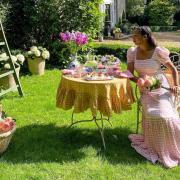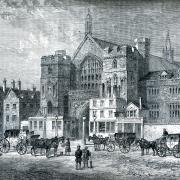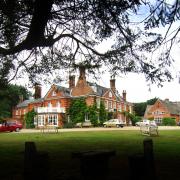A colouring book focusing on Norwich shawls is a fascinating look at a city fashion triumph – and a chance to enjoy creating vibrant art.
Norwich shawls were once a fashion must-have for well-dressed women around the world.
From society dances to Sunday services, the swirl of beautifully-coloured and patterned shawls, made in Norwich, swept through Britain, Europe and beyond.
Norwich shawl-makers shot to fame at the start of the 19th century with designs based on Indian shawls. Kashmiri shawls, hand-made from the wool of Himalayan goats, took up to three years to create, but a Norwich shawl, often woven from local woollen worsted fabric on foot-operated machines, could be completed in weeks.

They were soon flying off the looms and on to the shoulders of wealthy women, in ever bigger shapes and more intricate designs.
Fashion expert Stephen Worth has followed the story of the Norwich shawl in his colouring book, published by the city-based Costume and Textile Association.
After a career in fashion illustration, including as course leader for the fashion design course at the London College of Fashion, Stephen moved to Norwich, where he joined the Costume and Textile Association and became intrigued by Norwich shawls.
He said high-quality fabric, intricate designs and vibrant colours – particularly a rich red which became known as Norwich red - meant the shawls were particularly fine.
‘I have always been inspired by fashion and was delighted to be given the opportunity to create this book, said Stephen. ‘It is for everyone who likes to colour, and learn more about shawls and the fashions they were worn with.’

He hopes it will introduce a younger audience to Norwich shawls and the city’s importance in the fashion and textile industries.
Each of his illustrations is printed on high-quality paper, on one side only, so that the pictures, once coloured with pens, pencils or paint, could be framed or turned into cards. There are also shoes, boots, bags and bonnets to colour.
Stephen includes a guide to the colours which would have been used – but hopes readers will also enjoy creating their own colour combinations.
Shawl Colouring Book, The Golden Age 1790s to 1870s, by Stephen Worth, is published by the Costume and Textile Association and is available from ctacostume.org.uk

Did you know…?
- Shawls were originally worn by men and were one of the ways princes in India displayed their wealth and status.
- Paisley patterns could have been known as Norwichs. The design was copied from India and used by Norwich shawl makers, who called it the pine pattern. Years later manufacturers in the Scottish town of Paisley marketed the design as their own.
- Women attended classes to learn how to wear shawls to show off the fine cloths and colours.
- Norwich red was created in the city in the 1820s. It was made from the root of madder plants and a compound of tin compound, combined with chalky water from the Wensum, and could dye both silk and the heavier worsted cloth the same colour. So much yarn and cloth was sent from across Britain to be dyed in the Duke Street dye-works that it was said that the river itself ran red.
The Costume and Textile Association promotes Norfolk’s rich costume and textile heritage and the collections of the Norfolk Museums Service. It runs talks, workshops and events and has helped fund research and enhance museum collections. Founder Pamela Clabburn was curator of Strangers’ Hall Museum in Norwich and her research into her own family’s shawl-making history sparked a resurgence of interest in Norwich shawls.





























